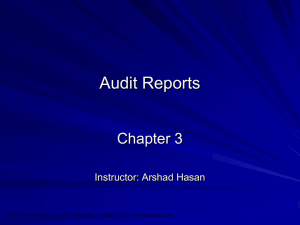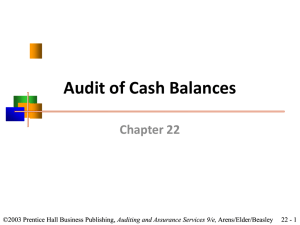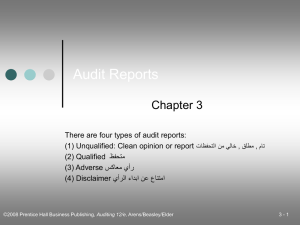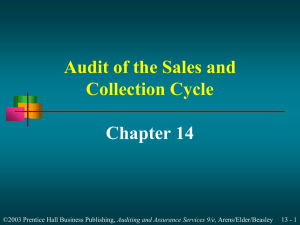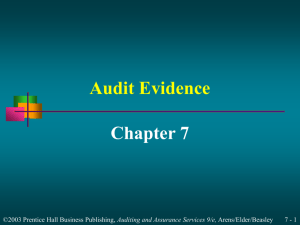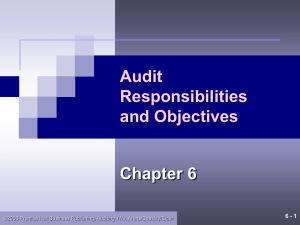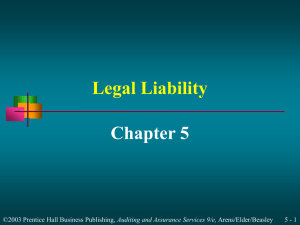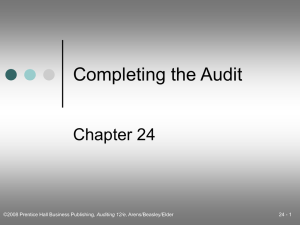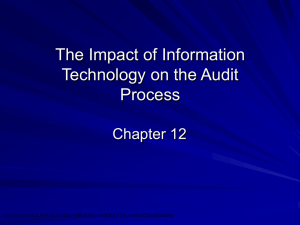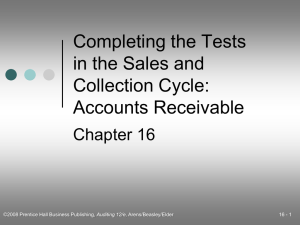Audit Evidence
advertisement
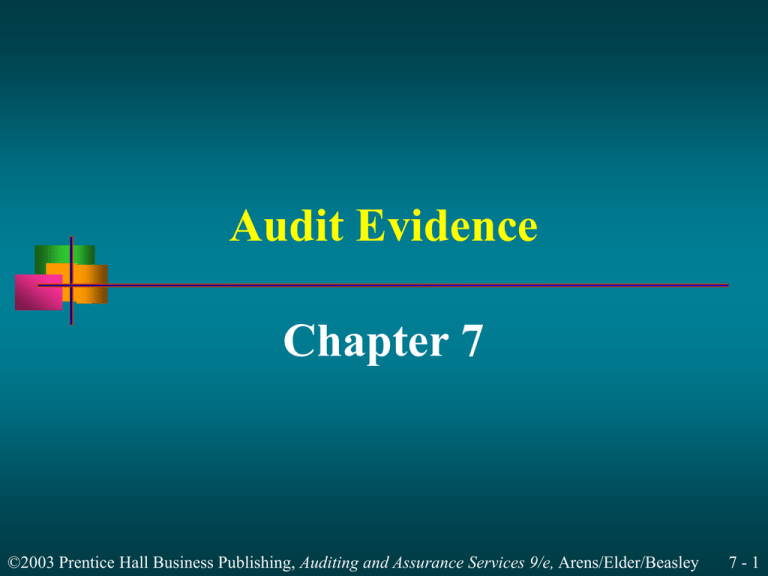
Audit Evidence Chapter 7 ©2003 Prentice Hall Business Publishing, Auditing and Assurance Services 9/e, Arens/Elder/Beasley 7-1 Learning Objective 1 Contrast audit evidence with evidence used by other professions. ©2003 Prentice Hall Business Publishing, Auditing and Assurance Services 9/e, Arens/Elder/Beasley 7-2 Nature of Evidence The use of evidence is not unique to auditors. Evidence is also used by scientists, lawyers, and historians. ©2003 Prentice Hall Business Publishing, Auditing and Assurance Services 9/e, Arens/Elder/Beasley 7-3 Learning Objective 2 Identify the FIVE audit evidence decisions that are needed to create an audit program. ©2003 Prentice Hall Business Publishing, Auditing and Assurance Services 9/e, Arens/Elder/Beasley 7-4 Audit Evidence Decisions 1. Which audit procedures to use = nature, research: by far the hardest – especially related to fraud. 2. What sample size to select for a given procedure / budget = extent 3. Which items to select from the population = nature 4. When to perform the procedures = timing 5. Who should perform the procedure = staffing ©2003 Prentice Hall Business Publishing, Auditing and Assurance Services 9/e, Arens/Elder/Beasley 7-5 Audit Program It includes a list of the audit procedures (tests) the auditor considers necessary. Table of contents covering objectives / To do list for account. Most auditors use computers to facilitate the preparation of audit programs. ©2003 Prentice Hall Business Publishing, Auditing and Assurance Services 9/e, Arens/Elder/Beasley 7-6 Learning Objective 3 Specify the characteristics that determine the persuasiveness of evidence. ©2003 Prentice Hall Business Publishing, Auditing and Assurance Services 9/e, Arens/Elder/Beasley 7-7 Persuasiveness of Evidence Appropriateness - Quality Sufficiency - Qty Combined effect: Examine client supporting doc. to support sales transaction: sample size = 120. Obtain external confirmation of A/R (sales transaction): sample size = 25. Persuasiveness and cost: Inspecting inventory for Nordstrom’s ©2003 Prentice Hall Business Publishing, Auditing and Assurance Services 9/e, Arens/Elder/Beasley 7-8 Appropriateness Relevance – to objective Independence of provider – source objectivity Effectiveness of internal controls Auditor’s direct knowledge Qualifications of individuals – source competence Degree of objectivity – b/w or grey Timeliness – B/S vs. I/S ©2003 Prentice Hall Business Publishing, Auditing and Assurance Services 9/e, Arens/Elder/Beasley 7-9 Learning Objective 4 Identify and apply the eight types of evidence used in auditing. ©2003 Prentice Hall Business Publishing, Auditing and Assurance Services 9/e, Arens/Elder/Beasley 7 - 10 Types of Audit Evidence – Tools! 1. Physical examination - Inventory 2. Confirmation – A/R 3. Documentation – Sales transaction 4. Analytical procedures – Expectation for allowance 5. Inquiries of the client – A/P difference - Corroborate 6. Recalculation – Dep. Expense, quantitative 7. Reperformance – Credit check, posting and summ. 8. Observation – Tour, Seg of duties ©2003 Prentice Hall Business Publishing, Auditing and Assurance Services 9/e, Arens/Elder/Beasley 7 - 11 Terms and Types of Evidence Terms Types of Evidence Examine Documentation Scan Analytical procedures Read Documentation Compute Analytical procedures Recompute Recalculation Simulation Reperformance ©2003 Prentice Hall Business Publishing, Auditing and Assurance Services 9/e, Arens/Elder/Beasley 7 - 12 Terms and Types of Evidence Terms Types of Evidence Trace Documentation Compare Documentation Count Physical examination Observe Observation Inquire Inquiries of client Vouch Documentation ©2003 Prentice Hall Business Publishing, Auditing and Assurance Services 9/e, Arens/Elder/Beasley 7 - 13 Learning Objective 5 Understand the purposes of audit documentation. ©2003 Prentice Hall Business Publishing, Auditing and Assurance Services 9/e, Arens/Elder/Beasley 7 - 14 Why keep a record of audit/WPs/Documentation? Legal Planning Learning Review SOX – keep WPs for 7 yrs and PCAOB inspection Client changes auditors: Babysitting ©2003 Prentice Hall Business Publishing, Auditing and Assurance Services 9/e, Arens/Elder/Beasley 7 - 15 Learning Objective 6 Prepare organized audit documentation. ©2003 Prentice Hall Business Publishing, Auditing and Assurance Services 9/e, Arens/Elder/Beasley 7 - 16 Audit File Contents and Organization Derrickson Associates Trial Balance 12/31/2003 Cash Accounts Receivable Prepaid Insurance Interest Receivable $165,237 275,050 37,795 20,493 Financial Statements and Audit Report Working Trial Balance Adjusting Journal Entries Contingent Liabilities Operations Liabilities and Equity Assets Analytical Procedures Test of Controls & Substantive TOT Internal Control General Information Audit Programs Permanent Files ©2003 Prentice Hall Business Publishing, Auditing and Assurance Services 9/e, Arens/Elder/Beasley 7 - 17 Permanent Files These files are intended to contain data of a historical or continuing nature pertinent to the current audit. Update and carryforward to CY WPs. ©2003 Prentice Hall Business Publishing, Auditing and Assurance Services 9/e, Arens/Elder/Beasley 7 - 18 Example – WP Structure 1000 series = Planning WPs (ex. 1100 = Planning Memo) 2000 series = Reporting (ex. 2100 = Trial balance) 5000 series = Assets, 5100 = Cash, 5110 = Cash Audit Program, 5120 = Cash Leadsheet, 5130 = Bank reconciliation for acct #XXXX. 8000 series = Income statement accounts ©2003 Prentice Hall Business Publishing, Auditing and Assurance Services 9/e, Arens/Elder/Beasley 7 - 19 Current Files Audit program – for each account General administration - budget Working trial balance – agreed to leadsheets and F/S Adjusting and reclassification entries – from supporting schedules and booked to T/B or passed. Supporting schedules – bank reconciliation, confirmation of A/R, completeness tests of sales transactions ©2003 Prentice Hall Business Publishing, Auditing and Assurance Services 9/e, Arens/Elder/Beasley 7 - 20 Relationship of Audit Documentation to Financial Statements FINANCIAL STATEMENTS Cash 122 Acc. …………………. WORKING TRIAL AJE’s BALANCE Expense 90 Prelim. AIE’s Final Cash Cash 212 (90) 122 90 ©2003 Prentice Hall Business Publishing, Auditing and Assurance Services 9/e, Arens/Elder/Beasley 7 - 21 Relationship of Audit Documentation to Financial Statements LEAD SCHEDULE – CASH Per G/1 Petty Cash A-2 5 Cash in Bank: General A-3 186 Payroll A-4 21 212 AJE’s (90) (90) A-1 Final 5 96 21 122 ©2003 Prentice Hall Business Publishing, Auditing and Assurance Services 9/e, Arens/Elder/Beasley 7 - 22 Relationship of Audit Documentation to Financial Statements A-2 Observe cash b/c pettty cash A-3 Bank Reconciliation Agreed to L/S A-3/1 Confirmation A-3/2 O/S Check List Dep. in transit, etc. ©2003 Prentice Hall Business Publishing, Auditing and Assurance Services 9/e, Arens/Elder/Beasley 7 - 23 Relationship of Audit Documentation to Financial Statements A-4 Bank Reconciliation Agreed to L/S A-4/1 Confirmation A-4/2 O/S Check List Dep. in transit, etc. ©2003 Prentice Hall Business Publishing, Auditing and Assurance Services 9/e, Arens/Elder/Beasley 7 - 24 Learning Objective 7 Describe how technology affects audit evidence and audit documentation. ©2003 Prentice Hall Business Publishing, Auditing and Assurance Services 9/e, Arens/Elder/Beasley 7 - 25 Effect of Technology Audit evidence is increasingly in electronic form. IT audit specialists! Auditors use computers to read and examine evidence (e.g., ACL) Software programs are typically Windows-based. ©2003 Prentice Hall Business Publishing, Auditing and Assurance Services 9/e, Arens/Elder/Beasley 7 - 26 End of Chapter 7 ©2003 Prentice Hall Business Publishing, Auditing and Assurance Services 9/e, Arens/Elder/Beasley 7 - 27
